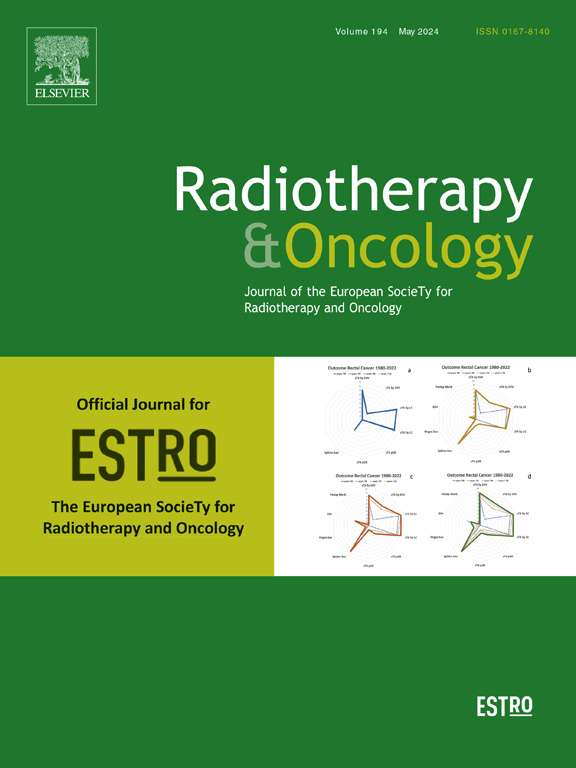Deep learning-based auto-contouring of organs/structures-at-risk for pediatric upper abdominal radiotherapy
IF 4.9
1区 医学
Q1 ONCOLOGY
引用次数: 0
Abstract
Purposes
This study aimed to develop a computed tomography (CT)-based multi-organ segmentation model for delineating organs-at-risk (OARs) in pediatric upper abdominal tumors and evaluate its robustness across multiple datasets.
Materials and methods
In-house postoperative CTs from pediatric patients with renal tumors and neuroblastoma (n = 189) and a public dataset (n = 189) with CTs covering thoracoabdominal regions were used. Seventeen OARs were delineated: nine by clinicians (Type 1) and eight using TotalSegmentator (Type 2). Auto-segmentation models were trained using in-house (Model-PMC-UMCU) and a combined dataset of public data (Model-Combined).
Performance was assessed with Dice Similarity Coefficient (DSC), 95 % Hausdorff Distance (HD95), and mean surface distance (MSD). Two clinicians rated clinical acceptability on a 5-point Likert scale across 15 patient contours. Model robustness was evaluated against sex, age, intravenous contrast, and tumor type.
Results
Model-PMC-UMCU achieved mean DSC values above 0.95 for five of nine OARs, while the spleen and heart ranged between 0.90 and 0.95. The stomach-bowel and pancreas exhibited DSC values below 0.90. Model-Combined demonstrated improved robustness across both datasets. Clinical evaluation revealed good usability, with both clinicians rating six of nine Type 1 OARs above four and six of eight Type 2 OARs above three. Significant performance differences were only found across age groups in both datasets, specifically in the left lung and pancreas. The 0–2 age group showed the lowest performance.
Conclusion
A multi-organ segmentation model was developed, showcasing enhanced robustness when trained on combined datasets. This model is suitable for various OARs and can be applied to multiple datasets in clinical settings.
基于深度学习的儿童上腹部放射治疗危险器官/结构的自动轮廓
本研究旨在建立一种基于计算机断层扫描(CT)的多器官分割模型,用于描绘儿童上腹部肿瘤的高危器官(OARs),并评估其在多个数据集上的稳健性。材料和方法使用儿童肾肿瘤和神经母细胞瘤患者的室内术后ct (n = 189)和覆盖胸腹区ct的公共数据集(n = 189)。17个桨被划定:9个由临床医生(1型)和8个使用TotalSegmentator(2型)。使用内部(Model-PMC-UMCU)和公共数据的组合数据集(Model-Combined)训练自动分割模型。用骰子相似系数(DSC)、95%豪斯多夫距离(HD95)和平均表面距离(MSD)评估性能。两名临床医生对15名患者轮廓的5分李克特量表进行了临床可接受性评分。根据性别、年龄、静脉造影剂和肿瘤类型评估模型的稳健性。结果model - pmc - umcu在9个桨中有5个桨的DSC平均值在0.95以上,脾脏和心脏的DSC平均值在0.90 ~ 0.95之间。胃、肠、胰腺DSC值低于0.90。模型组合证明了在两个数据集上增强的鲁棒性。临床评估显示了良好的可用性,两位临床医生将9个1型桨中的6个评为4以上,8个2型桨中的6个评为3以上。在两个数据集中,仅在年龄组中发现了显著的性能差异,特别是在左肺和胰腺中。0-2岁年龄组表现最差。结论建立的多器官分割模型在组合数据集上训练时具有较强的鲁棒性。该模型适用于各种桨,可应用于临床设置的多个数据集。
本文章由计算机程序翻译,如有差异,请以英文原文为准。
求助全文
约1分钟内获得全文
求助全文
来源期刊

Radiotherapy and Oncology
医学-核医学
CiteScore
10.30
自引率
10.50%
发文量
2445
审稿时长
45 days
期刊介绍:
Radiotherapy and Oncology publishes papers describing original research as well as review articles. It covers areas of interest relating to radiation oncology. This includes: clinical radiotherapy, combined modality treatment, translational studies, epidemiological outcomes, imaging, dosimetry, and radiation therapy planning, experimental work in radiobiology, chemobiology, hyperthermia and tumour biology, as well as data science in radiation oncology and physics aspects relevant to oncology.Papers on more general aspects of interest to the radiation oncologist including chemotherapy, surgery and immunology are also published.
 求助内容:
求助内容: 应助结果提醒方式:
应助结果提醒方式:


